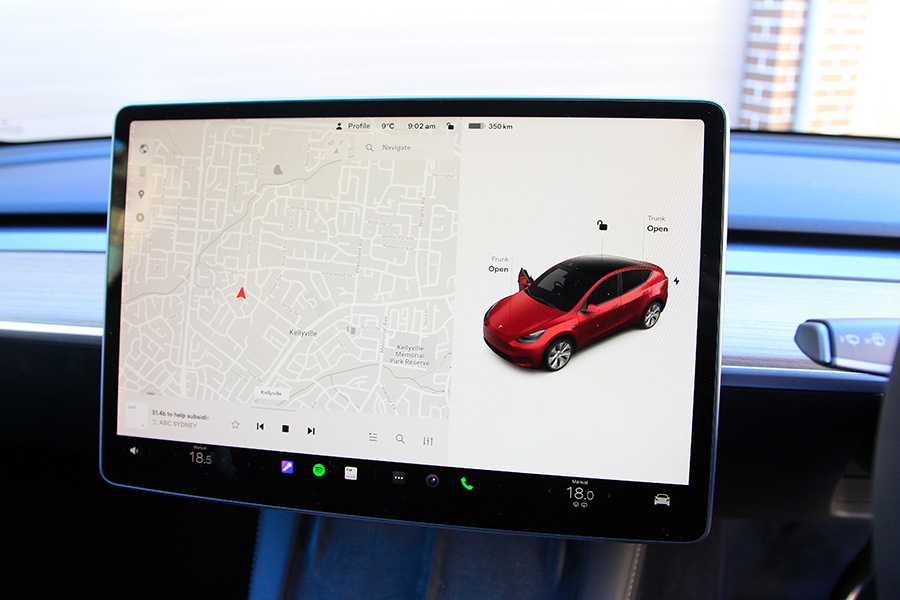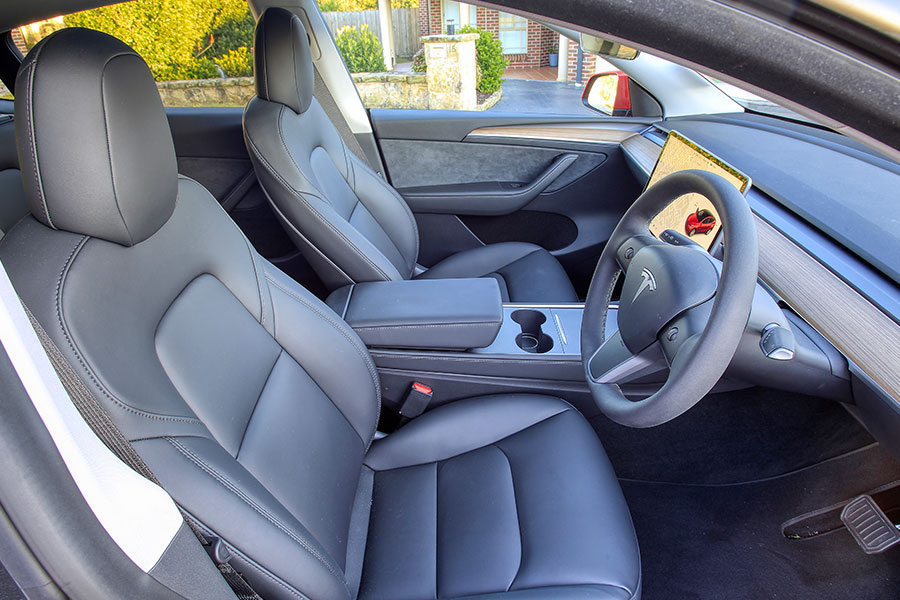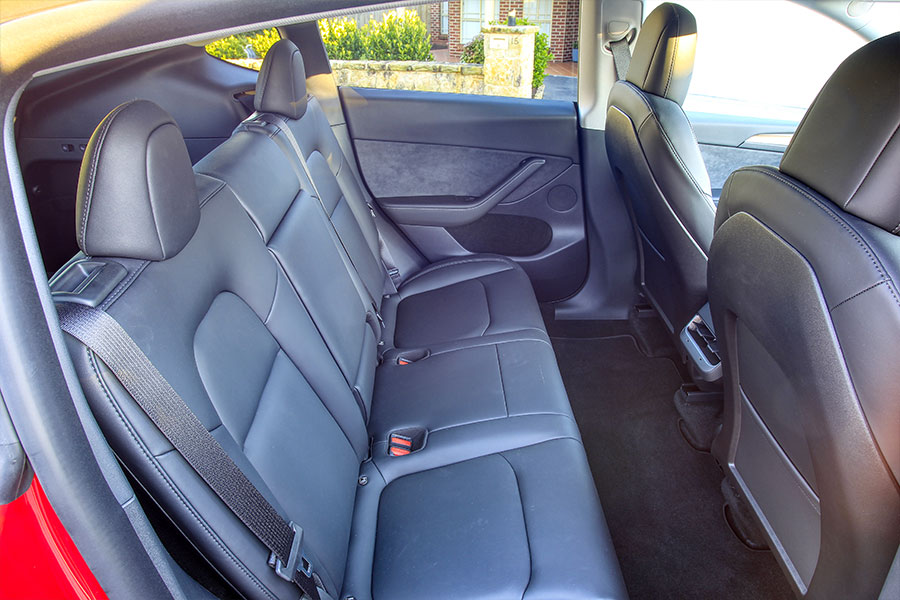Whether you’re ready to get started or would like to know more, we’re here to help.
By Toby Hagon, carsales.com.au
Australians have fallen out of love with conventional four-door sedans. So, it’s almost laughable that the best-selling electric car in the country (by some margin) is the Tesla Model 3. Or maybe it isn’t, because we haven’t had an affordable battery-powered SUV option. Until now.
The Tesla Model Y is the US electric car brand’s second – and most accessible - soft roader that takes all the goodness from the Model 3 and injects it into a higher-riding, slightly more spacious body that is likely to appeal to the masses that are increasingly gravitating towards SUVs.
So, let’s check it out and find out why the Model Y should overtake the Model 3 as Australia’s favourite EV.
Three times
As it is with the Tesla Model 3, the 2022 Tesla Model Y is offered in three model grades: Rear-Wheel Drive, Long Range and Performance.
At the moment, orders are only being taken for the entry-level and flagship versions with stock of the latter expected to start arriving later in 2022. The mid-grade Long Range is due to begin deliveries next year.
All three share the same body and are only visually differentiated by their unique alloy wheel designs.
Any variation in the level of standard equipment is minor, which leaves the size of the battery pack and the electric motors to do the bulk of the work in defining each model.
As its name suggests, the Rear-Wheel Drive gets a single motor driving the rear wheels whereas the Long Range and Performance feature a dual-motor set-up driving all four wheels. Long Range and Performance models also get bigger batteries to extend the EV range.
The 2022 Tesla Model Y Rear-Wheel Drive we’re testing costs from $72,300 plus on-road costs (it was initially $3400 more affordable, but Tesla hiked up the price a week after it launched.)
What that means is it is ineligible for the majority of EV rebates across the country, although NSW residents should at least be able to claim the stamp duty back.
It matches the base Tesla Model 3 for equipment, including leather-look seats (they’re vegan), power-adjustable steering wheel, power-operated front seats, heated seats in all five positions and a panoramic sunroof.

There’s also a 15-inch touchscreen and some of the best connectivity available on any car through the Tesla app.
The Model Y picks up a few extras over the Model 3. For starters, it rides on larger 19-inch alloy wheels, Premium Interior trim (compared to partial premium in the 3), a 13-speaker sound system, ambient lighting and a HEP filter for the cabin. The latter is designed to remove pollen, bacteria and pollution in what Tesla creatively calls Bioweapon Defense mode.
As for safety, the Tesla Model Y has a comprehensive suite of advanced autonomous driving aids with autonomous emergency braking (AEB), speed limit warning, lane keep assist, cameras facing forward, backwards and on each side, as well as blind spot warning.
As with the Model 3, the only colour you’ll get for your $72,300 (plus ORCs) outlay is white. It’s a classy metallic white but we’d also like to see at least one of the grey, blue, black or red colours offered at the same price (red adds $2900 to the price while the others command a $1500 premium).
You can also option a white interior for $1500, although it looks like it’s just waiting to proudly display any marks.
The Tesla Model Y Performance model gets no extra equipment other than the additional motor to drive the front wheels and 21-inch wheels surrounding larger brakes. It’s priced from $103,329 inclusive of luxury car tax but before on-road costs.
No word yet on details of the Model Y Long Range, other than it’ll lob during 2023.
As for aftersales, the Model Y gets a sub-standard four-year warranty that only covers the first 80,000km of driving.
Fortunately, the expensive part of the car – the battery – is covered by an eight-year/160,000km warranty, with a guarantee that it will hold at least 70 per cent of the original capacity over that time.
Servicing is required every two years and Tesla doesn’t quote prices, although it’s likely to cost somewhere around $1000 over the first five years for the average driver.
While the motor doesn’t need any maintenance, other things do, such as replacing the cabin filter every two years, the HEPA filter every three years, tyres rotated every 10,000km, brake fluid replaced every two years and air-conditioning serviced every four years.
It has rivals
It’s been a long time coming for the Tesla Model Y to reach Australian shores, having first launched in the US in 2019.
Back then it would have been a complete outlier, but now it has some keen competition. The Kia EV6 and Hyundai Ioniq 5 are the most obvious, but then there’s also the Model 3 it sells alongside.
From a price perspective, the Model Y also competes with the Mazda MX-30 Electric and the Lexus UX 300e. But neither of them offer the same driving range and tech as the Tesla.
It’s more likely the Model Y will steal sales from higher up the food chain and the prestige EVs from Mercedes-Benz, BMW and Audi, or possibly tempting some away from conventional petrol- or diesel-powered mid-size SUVs.
High rider
Under the skin, the 2022 Tesla Model Y SUV shares plenty with the Tesla Model 3 mid-size sedan.
The two are built on the same basic floorpan and are powered by the same electric motor and battery pack.
But the Model Y’s bulbous body is slightly bigger in every dimension: it’s 56mm longer, 72mm wider and sits 181mm taller. All of which explains why it isn’t as efficient or as quick as the sedan.

Not that you notice much difference when sitting in the front seat. By our tape measure, the Model Y uses the same dashboard, centre console and front seats as the Model 3.
Tesla’s signature minimalist design may be loathed by some – and something of a culture shock from those stepping out of a traditional luxury machine – but will be familiar to Model 3 drivers.
A strip of woodgrain breaks up the sparseness while a 15.0-inch touchscreen dominates the centre dashboard.
That display is the nerve centre of the car, not only doubling as the instrument cluster but also operating everything from the glove box and boot opening to all manner of infotainment features.
Farting indicators, anyone? The Model Y has you covered. Similarly, you can play arcade games (when stationary), monitor detailed energy usage data or stream music.
The sound system is also worth a mention. It’s punchy and clear, ensuring excellent reproduction of everything from hard rock to more melodic tunes.
It’s an impressive piece of kit, although we got frustrated with waiting for the built-in Spotify app) to come to life (often minutes or more).
The smart car
Like its other models, the 2022 Tesla Model Y is compatible with over-the-air software updates – an area of technology pioneered by Tesla.
Like your smartphone, the company regularly upgrades existing functions and adds more features, some of which may be fun and frivolous, others more about how the car drives. Either way, it ensures owners are kept up to date with the latest gadgets and safety devices.
It’s also worth delving deeper into that 15.0-inch touchscreen. As with an Apple phone, it requires learning of basic controls, but once you’re acclimatised there’s loads it can do and its operation becomes second nature.
Some things – such as operating the windscreen wipers – require some prior knowledge, but it’s all buried within the screen and its logical menus.
With eight external cameras, parking in tight spaces is helped by a very clear display and you can view any direction around the car. The cameras can also be used to record movements around the car when it is parked, which is a handy deterrent for thieves.
There’s a USB point in the glove box that allows you to download images from what is effectively a 360-degree high-resolution dash-cam.
Then there’s Autopilot, Tesla’s semi-autonomous drive system which can work extremely well in controlled environments.
On a well-marked freeway, for example, it usually does a great job of staying in its lane and dealing with other traffic, although occasionally it may unexpectedly slow down.
On suburban roads it’s far less convincing, often struggling to stay in the right part of the road and over-reacting or failing to react to obstacles.
All of which is a reminder that Autopilot is impressive tech but still needs a lot of work, as well as better communication with roadside infrastructure for it to be truly called Autopilot. Right now, it still needs a driver behind the wheel – so don’t be fooled by its name.
More for the family
Where the 2022 Tesla Model Y truly stands apart from its sedan sibling is in the back seat, which unleashes about 55mm more headroom compared to a Model 3.
It means six-foot-plussers can now sit in the back seat without having to stoop, although knee room behind the front seats is only just okay.

The vast glass roof creates an airy cabin and there’s decent vision for all occupants. Only the rear window is small, something that hampers the driver’s rearward view.
That said, the boot is quite deep and also has loads of storage underneath in two separate binnacles. It’s perfect for storing charging cables or valuables, something more important considering there is no luggage cover for items in the main section of the boot.
Add in the 40/20/40-split folding rear seats and the Model Y cements itself as one of the more practical mid-size SUVs on the market.
If that’s not enough, then a soft bag (or two) should slot into the frunk (or froot) under the bonnet.
Slow down
By Tesla standards, the 2022 Tesla Model Y is the slowest model it has ever sold here. But it is hardly a slouch.
With the ability to accelerate from 0-100km/h in 6.9 seconds, it is certainly swift enough for a mid-size family SUV.
Initial acceleration is on par with the latest Model 3 RWD. But an extra 157kg means the enthusiasm tapers marginally above 60km/h.
Again, it’s still energetic enough and does a terrific job of building pace around town or firing up for a country road overtake.
Throw in near-instant throttle response and generous pulling power that doesn’t rely on a transmission shuffling into the right gear and there’s never a time the Y is caught wrong-footed.
As for exactly how much power and torque is produced by the single rear-mounted electric motor is a mystery. When Tesla certified the Model Y RWD for sale in Australia it listed the peak power as being 208kW, but there are no specifications on the Tesla Australia website or in the owner’s manual to confirm this.
However, in the owner’s manual for Chinese Tesla models (where our Model Ys are built) is a table of motor outputs for all Model 3 EVs, which suggests the motor produces 194kW and 340Nm.
Out on the range
Similarly, the company doesn’t quote the capacity for the lithium-ion battery for the 2022 Tesla Model Y.
But, by our calculations using the energy usage and remaining range, the usable capacity of the battery in the 2022 Tesla Model Y Rear-Wheel Drive is 60kWh.
The Model Y claims to travel 455km on a charge (according to the WLTP standard), although the onboard range estimator was more like 435km in our car when the battery was topped up.
Our experience suggests that’s a realistic figure if you’re mainly in the city and suburbs; like all EVs, it’ll use more electricity at 110km/h on a freeway.
Average energy use hovered around 15kWh per 100km, sometimes less, versus an official claim of 14.6kWh/100km. So, it would cost something like $4.50 to cover 100km, which is the equivalent price of about two litres of petrol.
The Model Y’s battery can be recharged via a flap cleverly concealed in the left tail-light cluster. It’ll accept any Type 2 plug and take up to 11kW from a wallbox charger. That means a full charge in about 24 hours from a regular power point or as little as 5.5 hours on a wallbox.
Of course, one of the appealing aspects of owning a Tesla is access to the vast charging network that effectively doubles your charging options.
The faster Supercharger network will add hundreds of kilometres of range in less than an hour – and we’ve found Superchargers to be easier to use and more reliable than public charging stations.
Things that go bump
As for how it drives, there’s a tautness to the character of the 2022 Tesla Model Y that instantly reinforces its focus. It’s more of a corner carver than a comfy lounge on wheels.

The steering has been engineered to match, with a MINI-like directness that reinforces the athleticism.
The 19-inch Hankook Ventus tyres deliver plenty of grip and the Y’s low centre of gravity ensures its mid-corner manners are among the best in the SUV class.
Speaking of which, the body movement and firm suspension had our traction control firing to life while on an undulating country road, something that in turn disabled cruise control. It wasn’t an isolated incident, suggesting some more ESC tuning could be in order.
On a smooth freeway there were no such issues. Blame it on the bumps Aussie councils do so well, which you’ll never wonder where they are.
The Tesla doesn’t jar over them like a rock-hard sports car, but you’ll feel most imperfections as that connected chassis goes about its business.
Sitting higher than you do in a Model 3 means there’s more lateral movement that partially accentuates the bumps, which is a common trait in SUVs when compared to conventional sedans.
Staying at the Y
The 2022 Tesla Model Y is an important addition to the burgeoning electric vehicle landscape.
As the taller, more practical brother to the Tesla Model 3 that has quickly established itself as Australia’s favourite EV and was awarded carsales’ Best Electric Car for 2021, the Y builds on a successful formula and addresses the practicality limitations of the 3 sedan.
That said, Tesla’s pricing strategy – where it hiked the price a week after it first went on sale – is disappointing, particularly for customers that had waited almost three years for it to arrive locally.
But that probably won’t stop the Model Y from usurping its sedan sibling as the country’s best-selling electric car – if Tesla produces enough of them.
Importantly, the Model Y is not just a brilliant electric car, it’s a genuinely convincing mid-size SUV that undercuts some of its prime rivals from prestige brands.
It’s arguably the electric SUV the market has been waiting for.
How much does the 2022 Tesla Model Y Rear-Wheel Drive cost?
| Price: $72,300 (plus on-road costs) |
Battery: 60kWh (estimated) lithium-iron phosphate |
| Available: Now |
Range: 455km (WLTP) |
| Powertrain: Single permanent magnet synchronous motor |
Energy consumption: 14.6kWh/100km (WLTP) |
| Output: 194kW/340Nm (Tesla China owner’s manual) |
Safety rating: Not tested |
| Transmission: Single-speed reduction gear |
Disclaimer: Images supplied by carsales.
This article was prepared by an independent author. The information contained in this article represents the views and opinions of the original author, and is based on research carried out by the original author. The appearance of the article on Maxxia's website does not constitute an endorsement of its content by Maxxia in any way. The article has been made available for informational purposes only and should not be taken as advice. While all reasonable care has been taken to ensure that the statements made by the original author in the article are fair and accurate, Maxxia does not guarantee or warrant the accuracy or completeness of this information and will not be liable for, or in connection with, any loss or damage suffered as a result of any inaccuracies, errors or omissions or your reliance on this information. You should independently research and verify information before making any decision in respect of a vehicle.


